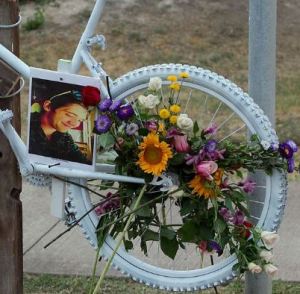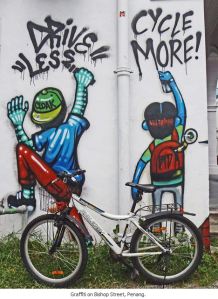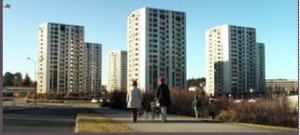William Spenser Vickerey, winner of the Nobel Prize for Economics, is  considered the father of Congestion Pricing. He first proposed it in 1952, for the New York City subway system, recommending that fares be increased in peak times and in high-traffic sections and be lowered in others. Elected officials considered it risky at the time, and the technology was not ready. Later, he made a similar proposal for road pricing.
considered the father of Congestion Pricing. He first proposed it in 1952, for the New York City subway system, recommending that fares be increased in peak times and in high-traffic sections and be lowered in others. Elected officials considered it risky at the time, and the technology was not ready. Later, he made a similar proposal for road pricing.
This article was written in 1992 by Todd Litman, executive director of the Victoria Transport Policy Institute, to summarize some of the defining principles set out in Vickerey's extensive path-breaking early extensive pathbreaking contributions which in many ways defined the field. This essay can be found in its original form in the website of the Institute at http://www.vtpi.org/vickrey.htm.
Tuesday, December 31, 2013
William Vickerey: On Principles of Efficient Congestion Pricing
Saturday, December 28, 2013
Getting away with M U R D E R
In memoriam 2013.
Streetsblog: Doing its job year after year in New York City.
Each year our friends over at STREETSblog in New York City publish a heart-rending testimonial to the mayhem that automobiles have wrought over the year on their city's streets and the cost in terms of lives lost by innocent pedestrians
 and cyclists. Putting names, faces and human tragedy to what otherwise takes the form of dry numbers, faceless hence quickly forgettable statistics is an important task. We can only encourage responsible citizens and activists in every city on the planet to do the same thing, holding those public officials (and let's not forget, "public servants") responsible for what goes on under their direct control.
and cyclists. Putting names, faces and human tragedy to what otherwise takes the form of dry numbers, faceless hence quickly forgettable statistics is an important task. We can only encourage responsible citizens and activists in every city on the planet to do the same thing, holding those public officials (and let's not forget, "public servants") responsible for what goes on under their direct control.Who is doing this job in your city?
--> Read on:
Saturday, December 21, 2013
Carnage on the roads and streets
An example for Penang: Once a week on Friday, the civil society journal and blog Streetsblog of New York City stubbornly reports the week's toll of human life, injuries and major property damage directly due to the errors, miscalculations, inattention and anti-social behavior of the automobile drivers of the city. This unrelenting reminder is a public drumbeat to draw the attention of the public, the media and the city government to the flaws of their system and behaviour. Let's have a look at how they do it.
Friday, December 20, 2013
Thursday, December 19, 2013
Too old to drive? So now what?
 At what point in life are we, you and I, "too old to drive"? When that fatal day comes, what do we do next? This is one of the unhappy surprises of contemporary life, but there is no reason that this need be personally devastating. It is after all foreseeable. In recent years we are starting to see programs emerging to help people foresee or deal with this painful transition, which for many is almost paralyzing where they live in places in which there are no decent alternatives to car travel. World Streets intends to present a series of working papers and thinkpieces on this topic over the course of 2014. This article by Adrian Davis is the first in this series.
At what point in life are we, you and I, "too old to drive"? When that fatal day comes, what do we do next? This is one of the unhappy surprises of contemporary life, but there is no reason that this need be personally devastating. It is after all foreseeable. In recent years we are starting to see programs emerging to help people foresee or deal with this painful transition, which for many is almost paralyzing where they live in places in which there are no decent alternatives to car travel. World Streets intends to present a series of working papers and thinkpieces on this topic over the course of 2014. This article by Adrian Davis is the first in this series.
Tuesday, December 17, 2013
Corbusier-Free Cities
To be quite frank, to the point and a bit rude, the famed 20th century Swiss architect, designer, artist and general polymath Le Corbusier when he donned his urbanist hat provided us with several striking examples of how to build a city for cars. We are extremely fortunate that most of them never got off the drawing board. But today, the Danish architect Henrik Valeur tells us about one that did and what perhaps Indian planners and urbanists can now do something to rectify.
Monday, December 16, 2013
Laying the Base for Public Bicycle Sharing in Penang
As we are seeing in these pages Penang in general and Georgetown in particular  are giving serious attention to the possibility of creating a public bicycle system for the city. As a first step they have issued a Request for Proposals which is shortly to come online. This is a great thing because there are many reasons to create conditions for safe and agreeable cycling on city streets across the state.
are giving serious attention to the possibility of creating a public bicycle system for the city. As a first step they have issued a Request for Proposals which is shortly to come online. This is a great thing because there are many reasons to create conditions for safe and agreeable cycling on city streets across the state.
[vimeo http://vimeo.com/80460045]
Saturday, December 14, 2013
Changing Mindsets: Mine, Thine and Theirs
The mind. . . yours, mine, theirs. This is the hardest challenge of all, and one that is right at the core of our Sustainable Penang/New Mobility Agenda  transformation project for 2014 and beyond. Fortunately we are not the only ones since it is the age-old habit of man to lock blindly into old ideas -- and particularly all those old ideas which are so omnipresent and unquestioned by all who surround us that they finally become invisible. How can we change something if we cannot see it? But let's hear what our old and great friend Jan Gehl has to say about this in a lecture which he gave recently to the annual conference of the European Foundation Centre on "Sustainable Cities: Foundations and our Urban Future" in Copenhagen.
transformation project for 2014 and beyond. Fortunately we are not the only ones since it is the age-old habit of man to lock blindly into old ideas -- and particularly all those old ideas which are so omnipresent and unquestioned by all who surround us that they finally become invisible. How can we change something if we cannot see it? But let's hear what our old and great friend Jan Gehl has to say about this in a lecture which he gave recently to the annual conference of the European Foundation Centre on "Sustainable Cities: Foundations and our Urban Future" in Copenhagen.
http://www.youtube.com/watch?v=Lid9ELzzT8Y
 # # #
# # #
Jan Gehl is a practicing Urban Design Consultant and Professor of Urban Design  at the School of Architecture in Copenhagen, Denmark. He has extensively researched the form and use of public spaces and put his findings to practice in a variety of locations around the world. His company, Gehl Architects — Urban Quality Consultants, focus strongly on the facilitation of public life in public spaces, often pushing the boundaries beyond common uses of the public realm. To Gehl, design always begins with an analysis of the spaces between buildings. Only after a vision has been established of what type of public life one wants to see flourishing, is attention given to the surrounding buildings and how they can work together to support public spaces.
at the School of Architecture in Copenhagen, Denmark. He has extensively researched the form and use of public spaces and put his findings to practice in a variety of locations around the world. His company, Gehl Architects — Urban Quality Consultants, focus strongly on the facilitation of public life in public spaces, often pushing the boundaries beyond common uses of the public realm. To Gehl, design always begins with an analysis of the spaces between buildings. Only after a vision has been established of what type of public life one wants to see flourishing, is attention given to the surrounding buildings and how they can work together to support public spaces.
# # #
Tuesday, December 10, 2013
Why the Dutch cycle (It's not an accident)
This posting is part of a stimulating dialogue in which two contrasting views of the role and practice of city cycling are discussed. Because the issues examined here are in many ways universal and fundamental to the success of a city cycling program, including the on-going early Spring of a much needed cycling Renaissance in Penang, we are pleased to be able to share this first article with our readers. (PS. We need more creative disagreement between informed people such as this. If everyone agrees too quickly mediocrity invariably results. Sustainability is hard and challenging work.)

Saturday, December 7, 2013
Bicycling to Solve Traffic Congestion in Penang
BICYCLING WITHIN A COMPREHENSIVE TRANSPORT PLAN,
TO SOLVING TRAFFIC CONGESTION
Dr Lim Mah Hui, Address to MPPP Council Meeting, October 25, 2013
 We must start to draw up a bicycle strategy, policy and plan and this must be integrated into town planning. It should be coherent, not piece-meal and ad hoc. It must be bottom-up and not just top-down, i.e., the bicyclists must be intimately involved in the planning. The plan must include a budget
We must start to draw up a bicycle strategy, policy and plan and this must be integrated into town planning. It should be coherent, not piece-meal and ad hoc. It must be bottom-up and not just top-down, i.e., the bicyclists must be intimately involved in the planning. The plan must include a budget --> Read on:
--> Read on:



